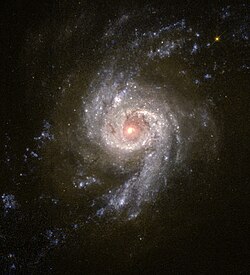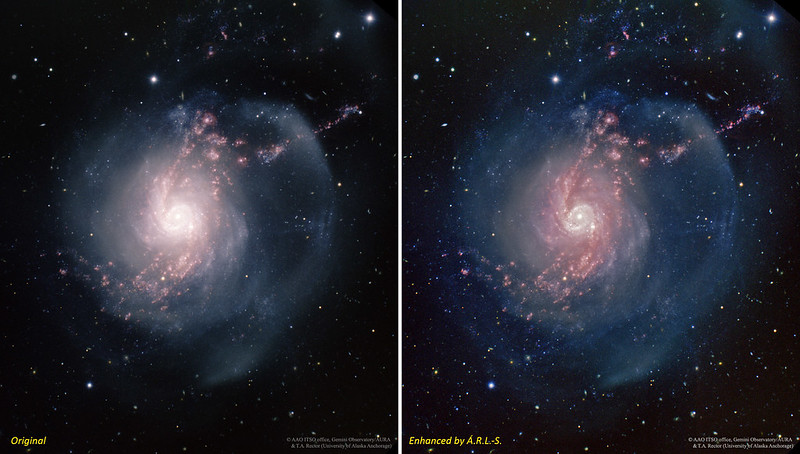Today's APOD appears to be
a repeat from January 9, 2008.
In some ways I find the image very beautiful indeed. What I like best is that the galaxy appears to be suffused with an inner, pearly light that almost seems to jump off the page. When the picture is seen against a dark background, you can almost imagine that the picture you're looking at is the real thing seen through a telescope. And then you can marvel at all the details you can see and the amazing, mildly yellow-white glow of the galaxy, seen against all the blackness. (But no... there is no way you could see so many details and so much color through a telescope.)
IC 342. Photo: Stephen Leshin.
Okay. And this is what I don't like much about today's APOD.
Compare T. Rector's image with Stephen Leshin's. Leshin's image lacks the "inner glow" of Rector's picture. But please note all the blue foreground stars in Leshin's image. There are no blue foreground stars at all in Travis Rector's picture. Most foreground stars there are yellow-orange, and a few are whitish.
The long and the short of it is that I don't like Travis Rector's treatment of blue objects in the universe, or his treatment of the color blue in itself. Often, he doesn't obey the "convention" when it comes astrophtography, which is that the exposure taken through the shortest-wavelength filter should be colored blue, the exposure through the longest wavelength filter should be colored red, and the exposure thought the intermediate filter should be colored green.
NGC 3310.
Photo: NASA and The Hubble Heritage Team (STScI/AURA)
NGC 3310. Photo: Adam Block.
Take a look at these two images of NGC 3310. They look very different, because they have been taken through different filters and mapped differently, but they both obey the rule that the hottest parts of the galaxy should look blue, the intermediate parts should be green, and the coolest one should be red. (Adam Block has also used an Ha filter to bring out pink emission nebulas.)
We can see, in both images, that the hottest, bluest part of NGC 3310 is the inner spiral and inner ring. The Hubble image shows us that the small inner bulge contains the coolest, reddest stars of the galaxy. (In Adam Block's image, this part of the galaxy is overexposed, although it does appear to have a faintly reddish tinge.) And we can see, in both images, that the outer, diffuse parts of the galaxy are less blue than the inner spiral. In the Hubble image these parts look almost green, but in Adam Block's picture they are still blue.
NGC 3310. AAO ITSO Office, Gemini Obs./AURA & T. A. Rector (U. Alaska Anchorage).
Now take a look at Travis Rector's picture of NGC 3310. It is indeed beautifully detailed, but notice the colors. The inner spiral is all red, and the inner ring, as well as the inner bulge, is white. The only blue parts of the galaxy are the outer, diffuse parts.
Why does the galaxy look like that? Well,
this page tells us that the filters used for this galaxy are a blue (B) filter, coded blue, one red (R)
and green filter, coded red (or green? or both red and green?), and one Ha filter, coded red. This means that the only parts of the galaxy that have any chance of looking blue in this picture are the parts that are neither generally red, generally green nor specifically hydrogen alpha-red. The only parts of the galaxy that fit that bill are the outermost ones, which are far less blue than the inner spiral.
I find Travis Rector's use of color confusing, and as a Color Commentator I can't entirely approve of him.
Ann
 Hidden Galaxy IC 342
Hidden Galaxy IC 342




